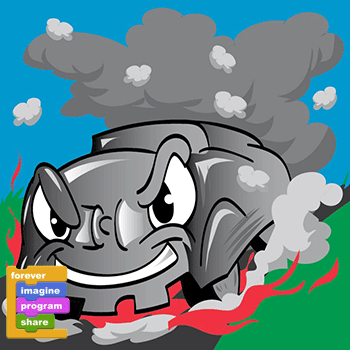Lesson Modules
Teaching Tips:
Question 1: Predict what’s happening in that crash test video where the car bounces backwards? Why does it do that?
The car bounces backwards because it was approaching the wall at such a high speed. It had so much energy that when it wasn't strong enough to move the wall it bounced back.
Race cars in Formula 1 races can reach speeds of up to 225 miles per hour. That’s 8 times faster than the fastest human alive can run! How do the race car drivers know that their cars are safe to drive at such extreme speeds?
Maybe you’ve seen one of these before:

This is called a crash test dummy.
It is designed mimic the size, shape, and movement of a human body in order to test how safe a car can keep a human in case of a crash.
What is a crash test dummy used for? Crash test dummies are used in crash tests! Crash tests are experiments that determine how safe a car is by running it into an obstacle like a wall or another car.
Teaching Tips:
Question 1: What is energy?
At this point in the lesson, the teacher should ask some students to share their answers. Most of the answers will be correct, at least in a way. But scientifically, energy is the power derived from the utilization of physical or chemical resources.
Question 2: What if the box is so heavy that you can’t move it at all? How much work did you do?
No work at all.
Work = Force x Distance
Work = Force x 0 ft
(what happens when you multiply something by zero?)
To know the answer, you have to know about energy.
Teaching Tips:
Here is the code: Lesson 4 Code
Here is a Step-by-Step guide to complete the code: Lesson 4 Code Instructions
Experiment | Observation |
1) Have the 1st car drive forward at speed 800 Have the 2nd car drive forward at speed 0 (Stop both cars before the impact.) | BEFORE What do you think is going to happen? Car 1 will push car 2. AFTER What happened to the first car after they hit? It pushed the second car.What happened to the second car after they hit? It moved backward.Did either car do work? If so, which one? The first car did work. Did it happen the way you expected it to? (answers will vary) |
2) Have the 1st car drive forward at speed 800 Have the 2nd car drive forward at speed 400 (Stop both cars before the impact.) | BEFORE What do you think is going to happen? The cars will push against each other without moving much.AFTER What happened to the first car after they hit? (answers will vary)What happened to the second car after they hit? (answers will vary)Did either car do work? If so, which one? (answers will vary) Did it happen the way you expected it to? (answers will vary) |
3) Have the 1st car drive forward at speed 800 Have the 2nd car drive forward at speed 800 (Stop both cars before the impact.) | BEFORE What do you think is going to happen? (answers will vary) AFTER What happened to the first car after they hit? (answers will vary)What happened to the second car after they hit? (answers will vary)Did either car do work? If so, which one? (answers will vary) Did it happen the way you expected it to? (answers will vary) |
Experiment | Observation |
1) Have the 1st car drive forward at speed 800 Have the 2nd car drive forward at speed 0 (Stop both cars before the impact.) | BEFORE
What do you think is going to happen?
AFTER
What happened to the first car after they hit?
What happened to the second car after they hit?
Did either car do work? If so, which one?
Did it happen the way you expected it to?
|
2) Have the 1st car drive forward at speed 800 Have the 2nd car drive forward at speed 400 (Stop both cars before the impact.) | BEFORE
What do you think is going to happen?
AFTER
What happened to the first car after they hit?
What happened to the second car after they hit?
Did either car do work? If so, which one?
Did it happen the way you expected it to?
|
3) Have the 1st car drive forward at speed 800 Have the 2nd car drive forward at speed 800 (Stop both cars before the impact.) | BEFORE
What do you think is going to happen?
AFTER
What happened to the first car after they hit?
What happened to the second car after they hit?
Did either car do work? If so, which one?
Did it happen the way you expected it to?
|
Teaching Tips:
Question 1: What was the coolest thing you learned today?
Any answer will do here. If time permits, have a short discussion with students about their answers.
Question 2: Check the concepts you understand. Don’t worry, this isn’t for a grade, it’s just so your teacher can check the classes’ understanding.
This is the students' self-assessment of their understanding of the material. You will see a bar graph once all the poll answers are submitted.
Work
Energy
Question 3: Energy is the ability to do WORK.
Question 4: If you push a block with a force of 5 and over a distance of 10 feet, how much work did you do?
50 units of work
(The unit of work is the joule (J) - the work expended by a force of one newton through a displacement of one meter)
At this point in the class the teacher should read some of the answers aloud, and ask students for their thoughts.
- Energy
- Work

